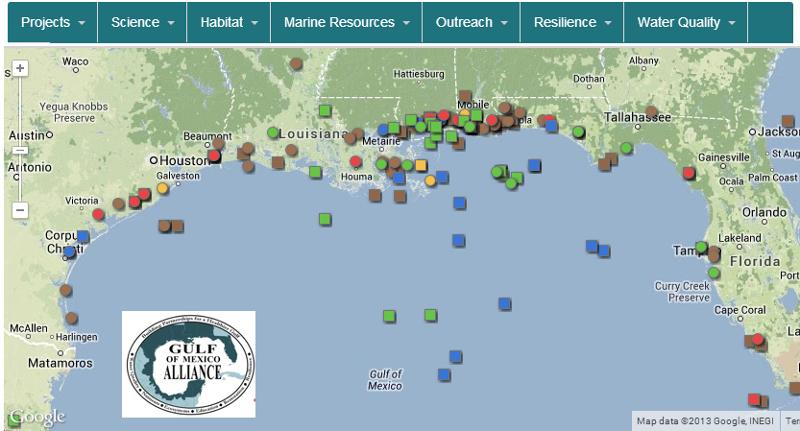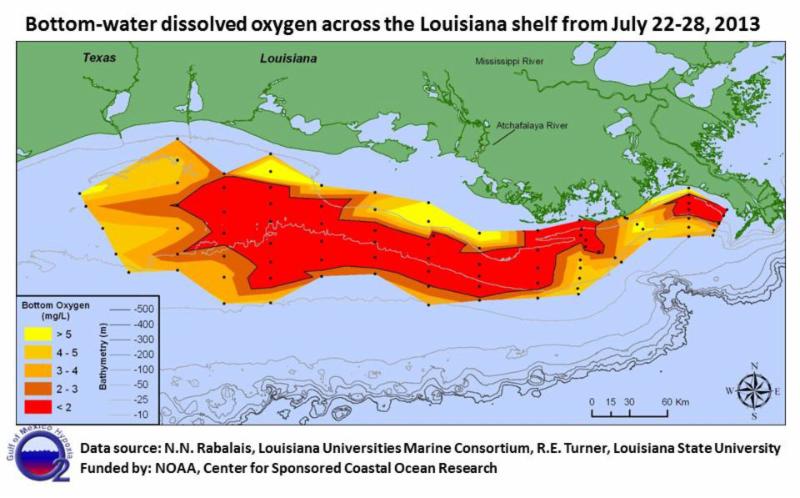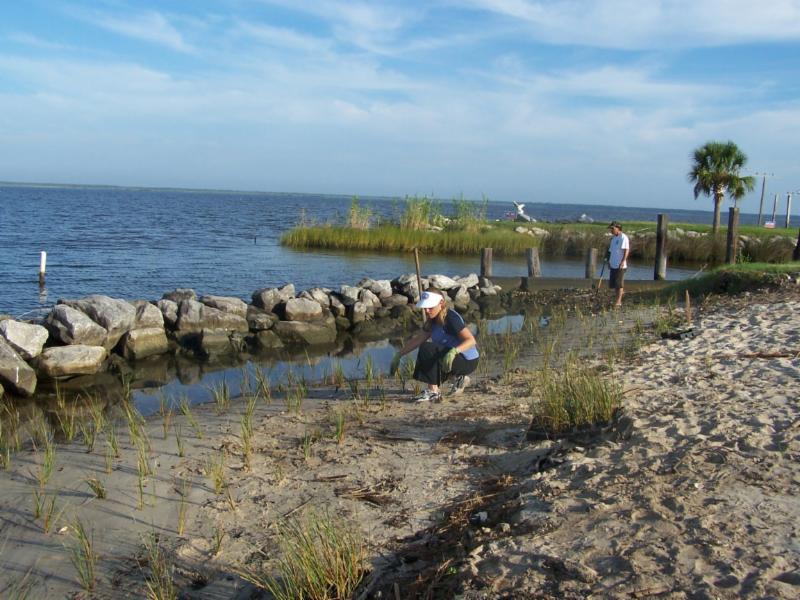Coastal Training Workshops Coastal Inundation Mapping July 29-30 ArcGIS II August 5-7 Advanced Topics Hydric Soils will be held Sept 9-10 For more information go to http://www.gulfalliancetraining.org/
|
5th Annual NOAA/NGI Hypoxia Research Coordination Workshop July 14 - 16, 2014 Stennis Space Center, MS Contact David KidwellGulf Hypoxia Monitoring Website
|
|
PRIORITY ISSUE TEAM CONFERENCE CALLS:
There are no calls schedule for July. Enjoy the 4th holiday. To contact Team Coordinators, see Quick Links below.
|
| MAPPING RESTORATION PROJECTS |
GOMA has been working hard on a map that will allow users to view restoration projects as well as research activities in progress across the Gulf. Click here to see the site!

Currently, the site contains projects from GOMA, GoMRI, NFWF, and early NRDA, with more to be added in the future. Coming soon are projects from states, Sea Grant, and National Academy of Sciences.
|
Come See Us!
We love visitors! With our new
sign out front, you can't miss us. Stop by 1151 Robinson Street in Ocean Springs, Mississippi and we'll show you around.
|
|
|
|
|
NOAA Predicts Average "Dead Zone"
|
|
On June 24, NOAA and partners announced they predict an average 'dead zone' for Gulf of Mexico. NOAA-supported modeling has forecasted this year's hypoxic zone to cover an area ranging from 4,633 to 5,708 square miles (12,000 to 14,785 sq. km) or about the size of the state of Connecticut. The prediction is based on models developed by NOAA-sponsored modeling teams and individual researchers at the University of Michigan, Louisiana State University, Louisiana Universities Marine Consortium, Virginia Institute of Marine Sciences/College of William and Mary, Texas A&M University, and the U.S. Geological Survey. The models rely on nutrient loading estimates from the USGS. The models also account for the influence of variable weather and oceanographic conditions, and predict that these can affect the dead zone area by as much as 38 percent. Reducing nutrient inputs and hypoxia are long-term goals of the Gulf of Mexico Alliance's Nutrient Priority Issue Team. The team has worked with many of these partners on products towards accomplishing the regional goals, including development of a Hypoxia Primer. For more information on Nutrient Team products, visit www.gulfofmexicoalliance.org.

|
|
Gulf of Mexico Alliance Welcomes New Alliance Management Team Members
|
The Gulf of Mexico Alliance is please to recognize new AMT members. Keven Claridge joins the team representing the state of Florida and the Florida Coastal Office within the Department of Environmental Protection. Kyle Graham joins the team from the state of Louisiana. He is the Deputy Executive Director for the Coastal Protection and Restoration Authority. The Alliance looks forward to the contribution these new members will make.
|
The Conference on Ecological and Ecosystem Restoration (CEER) will be held July 28 - August 1, 2014, at the Hilton Riverside in New Orleans, LA. CEER is a collaborative effort of the leaders of the National Conference on Ecosystem Restoration (NCER) and the Society for Ecological Restoration (SER). It will bring together ecological and ecosystem restoration scientists and practitioners to address challenges and share information about restoration projects, programs, and research from across North America. The Gulf of Mexico Alliance Habitat Conservation and Restoration Team will be coordinating a session on the Gulf Regional Sediment Master Mapping Plan. The focus will be on implementation of the GRSMMP. Learn more about the conference.
|
|
Gulf and Coastal Regional Quarterly Climate Summary
|
The Southern Regional Climate Center has released a new version of the "Gulf and Coastal Region Quarterly Climate Summa ry." They are designed for non-technical audiences and intended to provide high-level situational awareness of recent and upcoming climate events. The resource should also direct people to NOAA and partner products. Search all the regional assessments. ry." They are designed for non-technical audiences and intended to provide high-level situational awareness of recent and upcoming climate events. The resource should also direct people to NOAA and partner products. Search all the regional assessments.
|
|
GCOOS Selects New Director
|

The Gulf of Mexico Alliance would like to extend congratulations to Barbara Kirkpatrict, the new Executive Director of the Gulf of Mexico Coastal Ocean Observing System Regional Association. The Alliance would also like to wish a fond farewell to Ann Jochens. Her dedication to the region is much appreciated. GCOOS remains a strong partner in regional data collaboration.
|
|
National Integrated Water Quality Program Department of Agriculture National Institute of Food and Agriculture, closes July 3. Learn more.
Developing Biological Control Management of Invasive Phragmites australis DOI Fish and Wildlife Service, closes July 6, 2014. Read
Regional Conservation Partnership Program Department of Agriculture Natural Resources Conservation Service, closes July 14. Read more.
|
REGIONAL INITIATIVES
Gulf Restoration Updates
|
 RESTORE Council: Stay up to date with the RESTORE Council news and read the Initial Comprehensive Plan here. RESTORE Council: Stay up to date with the RESTORE Council news and read the Initial Comprehensive Plan here.
Alabama: The AL Coastal Restoration online project suggestion portal is now available. To receive instructions for submitting a project suggestion, please go here and click on "Submit Project Suggestions." It is important to note the AL Gulf Coast Recovery Council and the Gulf Coast Ecosystem Restoration Council have not yet made formal calls for project suggestions. The ADCNR will provide an update once either of these Councils make an announcement regarding a request for project suggestions. The online portal allows for the entry of suggestions for future consideration.
Mississippi: Follow the link to sign up for for the latest news on restoration planning and the MDEQ at http://www.restore.ms/.
Florida: FDEP has improved the navigation for users to the FL Deepwater Horizon restoration website. Responding to public's request for more information on projects being submitted, the improvements allow users to view and download the full project submittals.In addition, the Department has created an interactive map of Deepwater Horizon restoration projects that have been submitted. Public notices, outreach and education activities are available on the FDEP calendar. Check out Florida updates here.
Louisiana: With an understanding that the use of restoration funds will be guided by specific criteria, Louisiana is committed to maximizing its investment in oil spill recovery activities by implementing restoration projects that are consistent with the Louisiana Coastal Master Plan to the extent possible. In addition to submitting project ideas during the public meetings, restoration projects may also be submitted electronically to coastal@la.gov. Stay up to date on Louisiana's Coastal Master Plan restoration efforts by visiting CPRA's site. Information on Louisiana's NRDA restoration can be found here.
Texas: TCEQ held its first RESTORE Advisory Board meeting in October 2013. The Texas restoration web site is under construction ( www.restorethetexascoast.org) and will provide comprehensive information soon.
|
NOAA RESTORE Act Science Program: The NOAA RESTORE Act Science Program Framework and recent updates can be found here.
National Academy of Sciences' Gulf Research Program
To follow the NAS Gulf Research Program and register for updates, go to their website. Natural Resource Damage Assessment NRDA: The NRDA Trustees have released, " Assess Plan Restore." It is a guide to projects and planning contained in the Final Phase III Early Restoration Plan and Final Programmatic Environmental Impact Statement. Get a copy of the plan. National Fish and Wildlife Foundation's Gulf Environmental Benefit Fund: In early 2013, a U.S. District Court approved two plea agreements resolving the criminal cases against BP and Transocean which arose from the 2010 Deepwater Horizon oil spill. The agreements direct a total of $2.544 billion to NFWF to fund projects benefiting the natural resources of the Gulf Coast that were impacted by the spill. Read more about NFWF projects here.
North American Conservation Wetlands Act Fund:
As part of the criminal plea agreement involving the Deepwater Horizon oil spill, this Fund will receive $100,000,000. The purpose is for wetlands restoration and conservation benefiting migratory bird species and other wildlife affected by the oil spill. Click here to learn more. The US Fish and Wildlife Service has a "Vision for a Healthy Gulf of Mexico Watershed" and it can be found here.
|
|
Gulf of Mexico Research Initiative Update
|
The Gulf of Mexico Research Initiative (GoMRI) 2015 Conference planning is underway. This year's conference will seek to answer the questions "What have we learned, what does it mean and how can it be used?" A strong emphasis will be placed on the impact of the research and application of published research findings. The conference is scheduled for February 16-19, 2015 at the Westin Galleria Hotel in Houston, TX. Get more information.
|
|
|
|
|